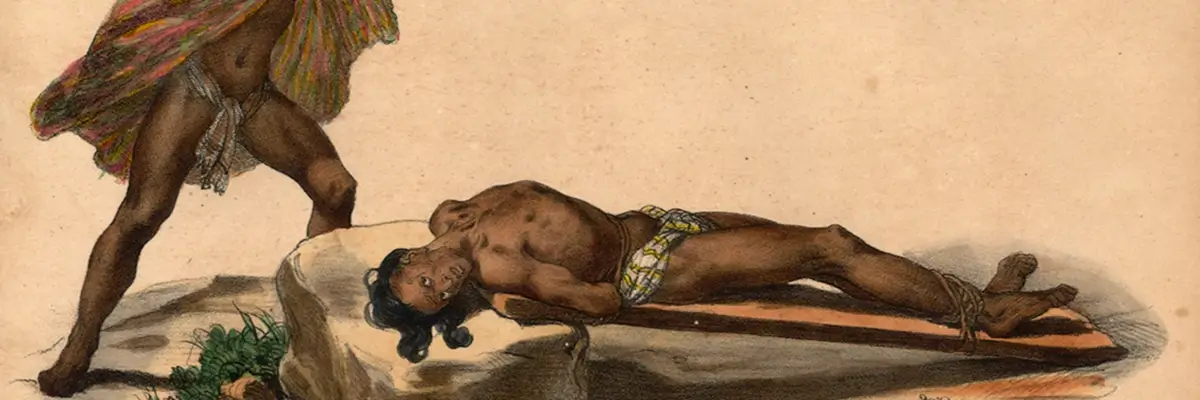What is human sacrifice?
Human sacrifice is the act of killing one or more human beings as a sacrifice to a deity or as part of a religious or cultural ritual. The practice has existed in various forms throughout human history and has been associated with a wide range of beliefs and customs.
The rationale for human sacrifice varies depending on the culture and religion involved. In some cases, it was believed that offering human life to the gods would ensure the fertility of the land, a bountiful harvest, or protection from natural disasters or other calamities. In other cases, human sacrifice was used as a means of appeasing angry or vengeful deities, or to demonstrate loyalty or devotion to a particular religious or political authority.
Examples of human sacrifice in history
Human sacrifice has been practiced in various parts of the world, including Mesoamerica, Europe, Asia, Africa, and Oceania. It has a long and complex history that spans many cultures and regions. While the practice has declined or been abolished in most parts of the world, it still exists in some forms in a few isolated places today. Below are some examples of the history and prevalence of human sacrifice in various cultures and regions.
Ancient Mesoamerica
Human sacrifice played a central role in the religious beliefs and practices of many pre-Columbian Mesoamerican cultures, including the Aztecs, Maya, and Zapotecs.
The Mesoamerican peoples believed that human sacrifice was necessary to appease the gods and maintain the cosmic order. They believed that the gods required regular offerings of human blood to keep the world in balance and prevent catastrophic events such as floods and earthquakes.
There were various methods used in human sacrifice in ancient Mesoamerica, including decapitation, heart extraction, and burning. The most common method was heart extraction, which involved cutting out the heart of a living victim and offering it to the gods.
Human sacrifice was a part of complex and elaborate religious ceremonies that often involved dance, music, and other forms of performance. The victims were typically prisoners of war, criminals, or slaves who had been specially chosen for sacrifice.
Human sacrifice had significant social and political significance in ancient Mesoamerica. It was seen as a way of demonstrating political and military power, and of consolidating control over subject peoples. The victims were often paraded through the streets before being sacrificed, and their deaths were seen as a public spectacle that reinforced the power of the ruling elite.
The practice of human sacrifice declined with the arrival of the Spanish conquistadors in the 16th century, who were horrified by the practice and saw it as evidence of barbarism and savagery. The Spanish colonisers worked to suppress the practice of human sacrifice and other Mesoamerican religious customs, and ultimately succeeded in abolishing it.
Today, human sacrifice is no longer practiced in Mesoamerican cultures, but the legacy of the practice continues to have a profound impact on the region’s history, culture, and identity. The Aztec practice of human sacrifice, in particular, has become a widely recognised symbol of the extreme brutality and violence of the pre-Columbian era.
Ancient Europe
Human sacrifice was also practiced in some ancient European cultures, although the practice was generally less widespread and less central to religious beliefs than it was in Mesoamerica.
The reasons for human sacrifice in ancient Europe varied depending on the culture and the time period. In some cases, it was believed that offering human life to the gods would ensure victory in battle or good harvests. In other cases, it was seen as a way of punishing criminals or appeasing angry or vengeful deities.
The methods of human sacrifice in ancient Europe were also diverse, and included hanging, drowning, burning, and burial alive, among others. One particularly notorious method was the “Bog Body” sacrifice, in which victims were killed and then placed in peat bogs, where their bodies were preserved over time.
Human sacrifice was often performed as part of elaborate religious ceremonies and rituals. In some cases, the victims were chosen from among the general population, while in other cases, they were specifically chosen for their perceived importance, such as prisoners of war or members of rival clans.
Like in Mesoamerican cultures, human sacrifice had significant social and political significance in ancient Europe. It was seen as a way of consolidating power and demonstrating the power of the ruling elite. It was also often associated with specific political or religious agendas, such as the suppression of rival clans or the spread of a particular religious faith.
As with Mesoamerica, the practice of human sacrifice in Europe declined with the arrival of Christianity and the spread of monotheistic religions. Over time, human sacrifice became increasingly rare and was eventually outlawed and condemned by Christian authorities.
South Asia
Human sacrifice was relatively rare in South Asia, although there is some evidence to suggest that it was practiced in ancient times in certain regions.
For example, the Indus Valley Civilization, which flourished between 2600 BCE and 1900 BCE in present-day India and Pakistan, is one of the few ancient South Asian cultures where human sacrifice is believed to have been practiced. Archaeological excavations at the Harappa site in present-day Pakistan have uncovered a number of skeletons with evidence of violent death, leading some scholars to speculate that human sacrifice was part of religious rituals in this culture.
In Hinduism, human sacrifice is not a part of the mainstream religious tradition. However, there are some isolated incidents of human sacrifice in certain Hindu sects, particularly those associated with the worship of the goddess Kali. These sacrifices are typically carried out in secret and are condemned by the wider Hindu community.
Today, human sacrifice is illegal in South Asian countries, and is not practiced in any mainstream religious or cultural tradition. However, there are still occasional reports of human sacrifice, particularly in remote or rural areas, where superstitions and beliefs in witchcraft and sorcery persist.
Africa
Human sacrifice has been recorded in many African cultures throughout history, particularly in sub-Saharan Africa. The reasons for human sacrifice varied depending on the culture and the time period. In some cases, it was believed that offering human life to the gods would ensure good harvests, fertility, or protection from evil spirits. In other cases, human sacrifice was used as a form of punishment or to settle disputes.
The methods of human sacrifice in Africa were diverse, and included strangulation, stabbing, burning, and drowning, among others.
Like in other cultures, human sacrifice had significant social and political significance in Africa. It was seen as a way of consolidating power and demonstrating the power of the ruling elite. It was also often associated with specific political or religious agendas, such as the suppression of rival clans or the spread of a particular religious faith.
The practice in Africa declined with the arrival of Islam and Christianity, which brought monotheistic religions that did not condone human sacrifice. Today, human sacrifice is illegal in most African countries, and is widely regarded as a barbaric and inhumane practice.
Oceania
Human sacrifice was practiced in some parts of Oceania, particularly among the Maori of New Zealand, with largely similar methods and reasons as described above.
It was generally less widespread and less central to religious beliefs than it was in Mesoamerica. The practise also declined, just as with the other parts of the world mentioned above, with the arrival of Christianity and the spread of monotheistic religions. However, the legacy of the practice continues to have a profound impact on the region’s history, culture, and identity.

